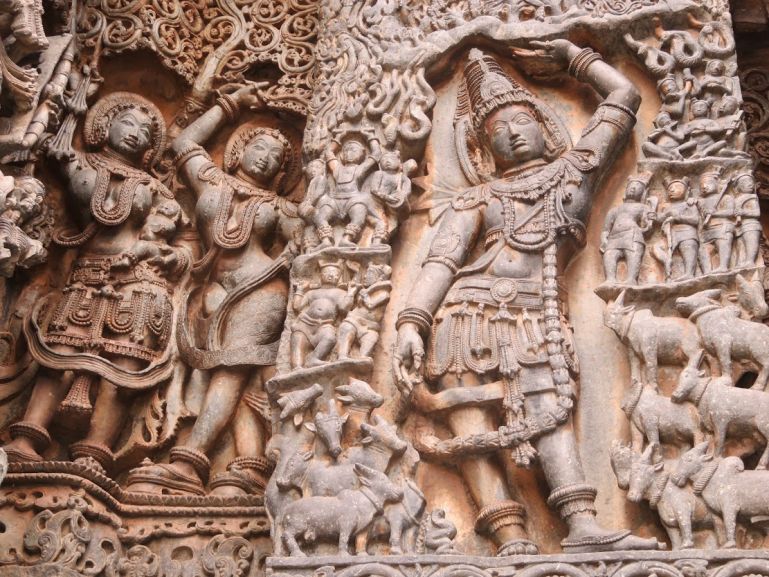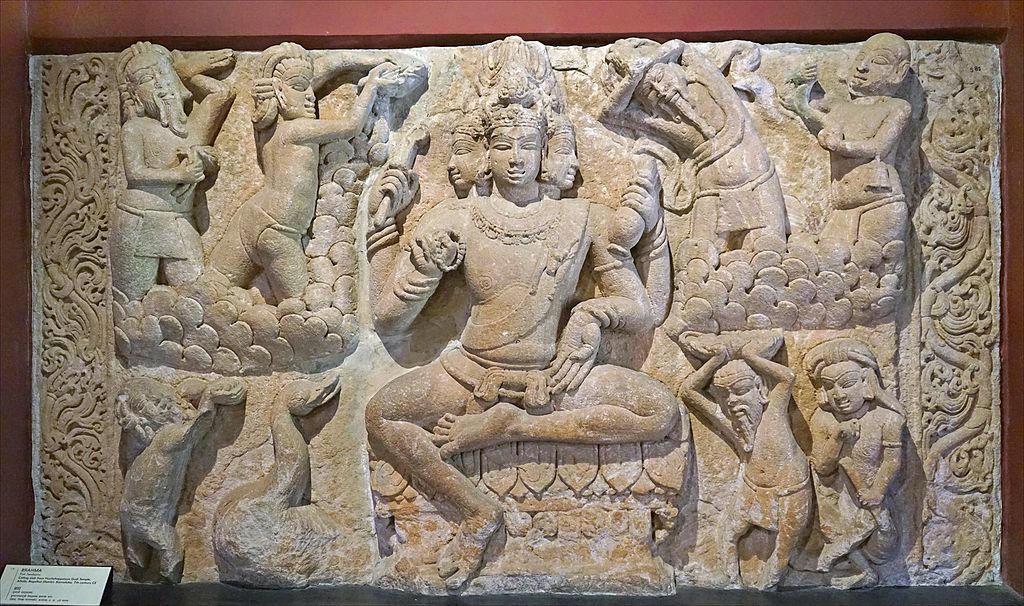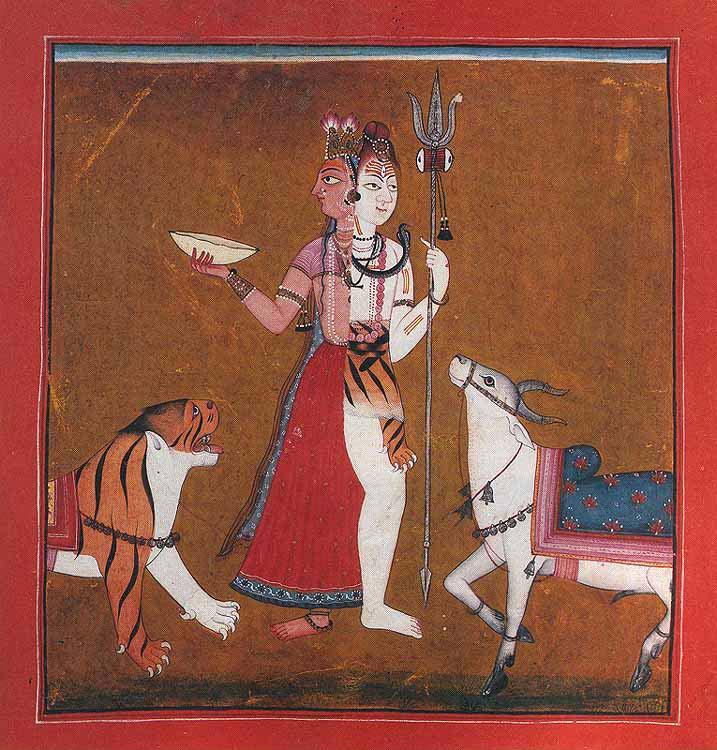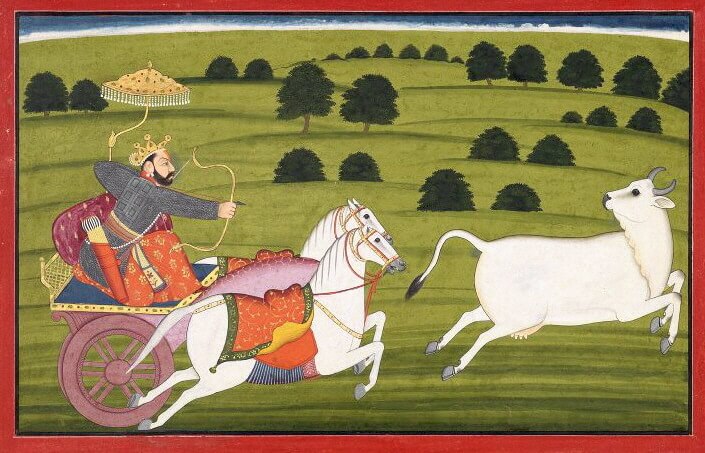The Birth of Life
Creation and Evolution

A Plurality of sources
Prominent modern religious - primarily the Judeo-Christian, texts suggest that God willed all of creation into existence and everything that there is was created in six days. In contrast to this, Hindu scripture offers a more detailed explanation of the creation of life, and takes time detailing it.
The Hiranyagarbha was first mentioned in the Rig Ved, and then was detailed further in the Purans and the Upanishads. Multiple Hindu texts mention some corroborating and differing, though not conflicting, statements of the creation of life.
The first mentions of creation of life are seen in the Rig Ved, in the Purusha Sukta (Rig Ved 10.129). The Purusha Sukta, lit. the Verse of Man, talks about how all people were created from one vast being.
Upanishads and their commentaries like the Satapath Brahman, add more details to the Rig Veda story, while later texts such as the Puranas - Bhagavad, Bhrama, Markandeya Puran - provide alternate retelling and also talk about how life and animals decended from the first men and women.
The concepts of evolution are well represented in the Hindu texts. The Nisadaya and Hiranyagarbha Sukta, talk about the formation of the universe through the big bang, the Purusha Sukta possibly sets us on the part of genetic evolution from the the first oceans.
While early texts allocate the responsibility of the creation of life to the Elemental Vedic gods, in later texts the responsibility of creation and maintaining it is bestowed on the Puranic Trinity of Brahma the Creator, Vishnu the Preserver and Shiva the Destroyer.
These stories also reflect a changing attitude in people. People of the ancient civilisations whether they were hunter-gatherers, cattle herders, or farmers, were dependent on nature and they understood its vagaries. Out of respect for annual flooding of river basins, rains, and changing seasons, their gods controlled the elements.
As civilisations grew, city-states became large kingdoms, and there was a distinction of labour amongst citizens. With the compilation and collation of the various Puranas, creation of life was attributed to Brahma.
The Cosmic Man
The Purusha Sukta (Rig Veda 10.129) suggests that the creation of all life was achieved by the sacrifice of a Cosmic Man.
The poet described the Vishwa Purush as a great being that was formed from the coalescence of matter from the cosmic egg. He is described as a being with a thousand heads, a thousand eyes and thousand feet. As soon as he formed he spread eastwards and westwards to cover the earth. He encapsulates the world and is bigger than the world by ten inches in all directions.
So mighty is the greatness of this being, that within himself he holds all living matter. He contains the past, the future and the present. He is so huge that the only one fourth of him is visible, the remaining three quarters are in the world’s beyond our ken. From the quarter that is visible in the world, are all the beings that take food, and the ones that dont take food created, that is all plants and animals.
To create all life, the Vishwa Purush offered himself as a sacrifice. In that grand sacrificial hohm, the summer season formed the fires, and spring the sacred oblations of ghee. The Vishwa Purush was the sacrificial offering. From this first all embracing sacrifice first came the animals meant for the fire sacrifice - the horse, and the ram. Birds that travel in air were born and the beasts of the forest were created. Farm animals with one row of teeth. Carnivores and animals with two rows of teeth and the sheep and goats.

In the sounds of this grand sacrifice, the chants of the Rig Veda & the Sama Veda were heard for the first time, and sounds of music, and the Yajur Veda. Indra and Agni, the Gods of Rain and fire came from his face and from his soul the air that breath life into all creatures.
Towards the end of the sacrifice were created the humans. From the head of the Vishwa Purush, were the Brahmin Priests formed, from his hands the Kshatriyas, - Warriors and protectors. From his thighs and legs were the Vaishyas and the Shudras formed.
There is a scientific basis in all life having orginated from a single source. Principals of evolution believe that 610 million years ago multicellular organisms began to appear in the oceans, having developed from singlecellular organisms.
Soon after the emergence of these first multicellular organisms, a remarkable amount of biological diversity appeared over approximately 10 million years, in an event called the Cambrian explosion.
About 500 million years ago, plants and fungi colonised the land and were soon followed by other animals. Amphibians first appeared around 364 million years ago, followed by birds and mammals around 129 million years ago, Gorillas and related apes around 10 million years ago and modern humans around 250,000 years ago.
Brahma and his children
While the Vedas as sanctified texts were still treated with prominence, the Vedic gods and trinities lost some of thier prominence and importance. These changes also reflected in how the Puranic texts treated the creation of life. In Bhagavat Purana texts, Brahma becomes the priest at the grand sacrifice of the Vishwa Purush. The cosmic man is provided to him as a sacrifice to create the world.

Brahma creates for creations sake, making no distinction for good or evil, the material and the spiritual and embuing all things with a beginning and an end.
Brahma first decided to create through his Sankalp, or Resolution. The first creation were formed of Tamas or the qualities of darkness. These included lower organisms, trees, shrubs, creepers and the insects and worms which constitute the primitive world.
Disatisfied with this creation, he used his mental powers to create four sons to aid his efforts in creation. These four sons - Sanaka, Sanada, Sanatan and Sanatkumara, were interested only in austerities and declined to support their father in his endeavours.
Decending into anger, Brahma willed further creation. From his thighs and the hair on his back jumped out demons and creatures that revelled in the dark. Of these there were some who charged at Brahma in a canabalistic fury to eat him, these he named Yakhsas, and there were those who surrounded Brahma to protect him, and they were named the Rakshas.
At this stage Brahma saw creation stalled. He had reached the limits of thought and what his resolve alone could achieve. In consternation he furrowed his brow and from his forehead leaped forward the mighty Rudra - Shiva. Shiva appeared in his Ardhanarisvara form, in which he shared his body with his consort, the Devi Parvati.

The form of the Ardhnarisvara then seperated into the divine male and the divine female, and gave to Brahma the idea of how to continue creation - by copulation.
Then from his own self he formed Saraswati his consort and the embodiment of knowledge and he embraced her, and thus were men born. At this the lady in shock thought, “How can he embrace me, after having produced me from him? I shall hide myself.”
Saying this, she became a cow, Brahma took the form of a bull and embraced her, and thus were cows born. She became a mare, and he became a stallion. She became a she-goat and he became a Ram. Thus they created every animal that exists in pairs of male and female, from the largest to the tiniest.
And when Brahma had thus created all manner of creatures he stopped.
While the incestuous nature of Brahma’s actions are not the lesson to be taken from this telling, the key takeway is to understand the role of the female and the male. Only in the union of the two is creation possible.
Despite the detail of the creation that is attributed to Brahma in the Puranas, in most traditions he is a secondary creator. Willed into being by a greater god or power. In the most popular Vaishnava traditions, Brahma was born from a lotus that grew from Vishnu’s navel as Vishnu rested on the primordial ocean. In Shaivite and Shakta traditions where the primary deity is Shiva or the Devi, it is their will that sets creation into motion. But despite most texts treating Brahma as a deputy, he is still accorded the Rank and title of Parampita - The supreme father
Evolution of man
In their accepted roles in the trinity - Brahma is responsible for the creation of life, Vishnu responsible for the preservations of life, and Shiva the dissolution of the worlds in preparation for renewed creation.
Vishnu is responsible for preserving the balance of good and evil in the world. Through the ages of man he has taken different incarnations and forms to achieve this.
The ancestry of our ancients developed from quadrupeds to apes to humans. Animals evolved to their new environments learning to eat different types of food, mating and developing in different circumstances and adapting to a new world.
Human behaviour also evolved as we moved from small tribes of hunter-gatherers to farming villages, from towns to cities and the empires of the modern world.
The incarnations are a representation of the ascending scale of divine creation, which shares similarities with the modern theory of evolution.
The forms taken by Vishnu move through the stages of evolution, from living in the sea to living on land to the formation of great cities and kingdoms.
The first four forms are
- Matsya, the fish
- Kūrma, the turtle
- Varahā, the boar
- Narasimha, the half-man, half-lion

The next incarnations have a more recognisable, human form.
- Mohini, the divine lady, the essence of female beauty and allurement.
- Vamana, the dwarf
- Parashuram, the warrior sage, a hero, still in forests and villages, tribal people
- Rama, the ideal ruler, the first kings of cities and city-states
- Krishna, The Divine Teacher for the first kingdoms & empires
Sri Bhaktivinoda Thakur, in his Śrī Krishna-Saṁhitā1 proposed that the avatars of Vishnu shows evolution from the Paleozoic to the Cenozoic ages.
In chapter 3 he says
yad yad bhāgavato jīvas tat tad bhāgavato hariḥ
avatīrṇaḥ svaśaktyā saḥ krīḍatīva janaiḥ saha
matsyeṣu matsya-bhāvo hi kacchape kūrma-rūpakaḥ
meru-daṇḍayute jīve varāha-bhāvavān hariḥ
nṛsiṁho madhya-bhāvo hi vāmanaḥ kṣudra-mānave
bhārgavo sabhyavargeṣu sabhye dāśarathis tathā
sarva vijñāna-sampanne kṛṣṇas tu bhagavān svayam
tarka-niṣṭhanare buddho nāstike kalkir eva ca
When the souls of creature receive various forms according to their nature, the Supreme Lord agrees to accompany them by incarnating in their forms and enjoying their pastimes.
When the living entities are fish, he accepts the fish incarnation. When the living entities accept the position of vajra-daṇḍa, the Lord incarcates as the turtle. When the lives of people gradually become Meru-daṇḍa, the Varāha incarnation is apparant.
(The exact meaning of Vajra-daṇḍa and Meru-daṇḍa in this context are not evident to me, so I have left them untranslated.)
When the living entities accept the combined position of human and animal, the Lord accepts his incarnation of Narasimha. When the living entities are short, He appears as Vāmana. When the living entities are uncivilised, He comes as Paraśurāma. When they are civilised, He appears as Rāmacandra.
When the living entities possess the wealth of practical knowledge, then Lord Kṛṣṇa Himself appears. When the living entities develop the tendency for argument, the Lord appears as Buddha. And when they are atheistic, the Lord comes as Kalki.
The last verse mentions two more human incarnations of Vishnu.
- Gautam Buddha, the proponent for a new way of living.
- Kalki, the tenth avatar who will prepare the earth before its eventual destruction.
Buddha and Kalki both appear in the 3rd to 6th Century period, and may even have been introduced into later versions of the Greater and Lesser Puranas.
In 12th century Bhagavad Purana texts, we see these words
Then, in the beginning of Kali-yuga, the Lord will appear as Lord Buddha, the son of Anjana, in the province of Gaya, just for the purpose of deluding those who are envious of the faithful, and taking them away from the vedic rituals.
The Buddha may have introduced as a means to protect orthodox Brahamanism from the influence of Jainism and Buddhism. By making the Buddha an incarnation of Vishnu, there may have been an attempt to achieve two goals. Bring the positive aspects of Buddhism into the fold of Hinduism and also give a reason to the significant and high profile conversion to Buddhism from the Gupta and Maurya kings and their subjects.
Kalki first appears in the Mahabharata, only once, and is an extension of the Parashuram avatar, as he destroys the evil doers one final time. There is brief mention in the Vishnu Purana, Matsya Puran and Bhagavad Purana
Kalki next appears in the Kalki Purana, which was written in Bengal between the 1500 - 1700 CE. Kalki is meant to prepare the way for the end of the time by destroying all that is evil and meant to guide the just and devout to heaven.
The Kalki Purana also sets out the clear and tidy list of Vishnu’s ten avatars with the Kalki avatar as the last on his horse and with his sword.
In this there is a commonality with characters from the Apochrypha texts of the Bible - The Book of Revelations. Apart from the obvious comparisons with Jesus, the Horse mounted warrior Kalki is similar to the four horsemen who are responsible for destroying evil people. This may again be a case of Hindus adapting to the changing environment around them. Christianity started appearing in India from around the 4th century CE.
For whatever the reason of the addition, It does not take away the understanding of evolution that is inherent in Hinduism. Bhaktivinoda Thakur mentions further in the Krishna Saṁhitā
jīvānāṁ krama-bhāvānāṁ lakṣaṇānāṁ vicārataḥ
kālo vibhajyate śāstre daśadhā ṛṣibhiḥ pṛthak
tat tat kālagato bhāvaḥ kṛṣṇasya lakṣyate hi yaḥ
sa eva kathyate vijñair avatāro hareḥ kila
After consideration, the sages have divided the history of the living entities’ advancement into ten periods of time, Some say twenty-four periods, and yet others say eighteen. Each period has different symptoms, with each successive period building on the previous. In each period the incarnation that appears is fit for that period.
Sky Father and Earth Mother
We cannot leave the topic of creation of life without considering the creation story of Dyaus and Prithvi, Sky father and Earth mother.
Most classic religions promote the principle of the first parents. These first progenitors usually have a responsibility for the birth of the second generation of gods, who essentially form the pantheons. Ironically, these first gods are then relegated to a forgotten chapter of history. This particular phenomenon is also visible in the Hindu scriptures, with Dyauṣ and Prithvi, Father Sky, & Mother Earth.
Dyauṣ is the father, the Sky, who impregnated Pṛthivī, the earth and mother, in the form of rains. He is the father of Indra (future king of the Gods, and lord of rain), Agni (Fire) and Ushas (the Dawn), and is said to have caused the subsequent growth of the flora and fauna on the earth.
Dyauṣ is mentioned in five verses of the [Rig Veda][1] in simple invocations. In the RV Hymn 1.89, Dyauṣ is first mentioned by name and given the title of Father
In the earlier Vedic traditions, Pṛthivī is regarded as mother Earth, a bestower of fertility in conjunction with her divine partner Dyauṣ. In that role she became a mother to the second generation of Gods, Indra, Agni, Usha and others. Dyauṣ and Pritihvi are said to provide for all creatures in the worlds, they are a mighty pair, who never fail and keep everyone safe.
Despite the importance given to both Dyauṣ and Pṛthivī in the hymns, the fact that the number of hymns itself is not many, leads us to believe that the later Vedic and post Vedic period paid less import to the pair of the Sky and Earth. As more and more elements in nature were recognised, more and more gods appeared to control those natural phenomenon. In the Puranic texts Dyauṣ disappears, and Prithvi is relegated to diferent roles. She becomes a consort to Vishnu and from a benovelent goddess she becomes a self absorbed goddess who does not care about people.
In this last tradition, we are introduced to the King Prithu, and an alternate narrative to the creation of living things. Prithu was the first king formed from the arms of the Vishwa Purush, and he is given dominion over the world. Now despite his and his subjects efforts at tilling the earth, Prithvi does not give up her bounty, and the world is suffering a famine.
In anger, the king shoots an arrow through the earth, however Pṛthivī takes the form of a cow and runs away. Prithu gives chase and Pṛthivī takes refuge with Brahma, while admonishing Prithu for attacking a woman. In response Prithu tells her “When the happiness of many is secured by the destruction of one malignant being, the slaughter of that being is an act of virtue.”

Overcome at length, the Earth declared that if the King allowed her life, she would restore her bounty as developed from her milk. By granting life to the Earth, Prithu was as her father, and she thence derived the patronymic Pṛithvī.
The concept of the Father Sky and Mother Earth is something that is found across other Indo-European religions as well. It is possibly a function of migratory patterns of people starting from central Asia and moving to civilisation areas like Mesopotamia, Greece, Mongolia and India. It is believed that these peoples do share a common ancestry at a very early stage of evolution.
In Mesopotamia, the pair of Anu & Ki were the parents of the Annunakki whose most prominent god was Enil, the god of air. In Greece the pair of Oranus and Gaia performed a similar function as the parents of the Titans. The Mongoloid shamanistic religion emphasised the worship of Tengri – The great blue god of the sky.
Beyond the Indo-Asian regions, a similar mythology is also seen in the Maori mythology from New Zealand.
Ranginui is the sky father while Papatuanuku was the earth mother. In the Maori tradition, Ranginui and Papatuanuku clung to each other tightly. Thus the children that were born to them were held between them in complete darkness. The children, in a bid to escape this darkness, separated their parents by pushing them apart.
Ranginui and Papatuanuku continue to grieve for each other to this day. Ranginui’s tears fall towards Papatuanuku to show how much he loves her. Sometimes Papatuanuku heaves and strains and almost breaks herself apart to reach her beloved partner again but it is to no avail. When mist rises from the forests, these are Papatuanuku’s sighs as the warmth of her body yearns for Ranginui and continues to nurture mankind.
In the Indo-European traditions, the god of thunder and rain, normally usurps the role of the sky father. In the Greek traditions Cronus catrated Oranus, and deposed him. He was further challenged and defeted by Zeus who took over the role of the king of the gods and wielder of the thunderbolt by defeating and imprisoning the Titans. One tradition in Hinduism, does say that Indra killed Dyauṣ taking Pṛthivī as his wife, before taking over Dyauṣ’ role as king and as lord of rains.
The character of the earth goddess on the other hand is allowed to live on, and has a greater glory in all the traditional faiths. In Hinduism she continues in her function as birth giver and caretaker. She is patient as no other as she bears on her chest the weight of all the living. In Greece she remained an all-pervading deity, oaths sworn in Gaia’s name were binding on gods and humans and were rarely, if ever, broken.
Featured Image: Krishna Lifting Mount Govardhan, Relief from Hoysaleswara temple, Halebidu, Karnataka